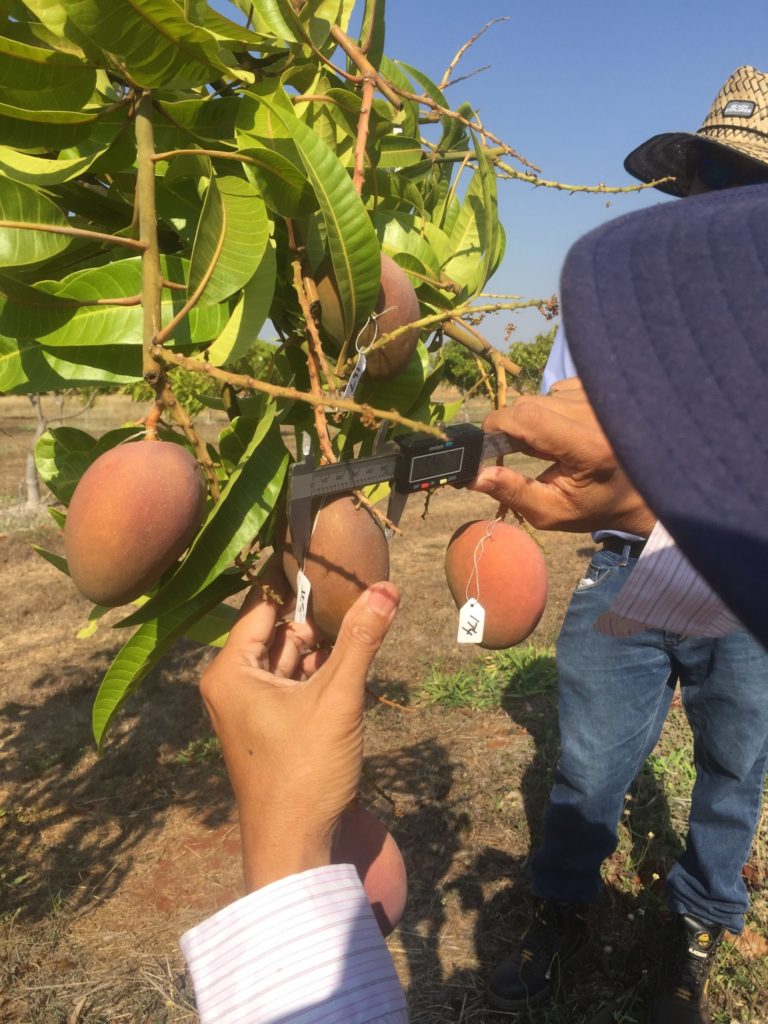On a mango farm on the outskirts of Darwin, horticultural researcher Maddison Clonan inspects the spiky inflorescences amid the long green leaves of the mango trees (these ones are Kensington Pride). While they don’t look like it, these spikes are the beginnings of this season’s mango crop, and this close scrutiny could have important outcomes for future mango production in the Territory.
Mangoes are the Northern Territory’s largest horticultural product. In 2018/19, nearly half of the national crop, which was worth $199 million, was produced in the Territory. Most of the Northern Territory’s mangoes are grown in the greater Darwin area. There are also substantial orchards around Katherine. Kununurra, just over the border in northern Western Australia, is another important growing region.
Flowering by degrees: the role of temperature in mango development
Maddison and her colleagues at the Northern Territory Department of Primary Industry and Resources (DPIR) are working to improve their understanding of mangoes with a view to provide industry with information to improve productivity.
One of the areas they are looking at is mango flowering, specifically at the cues that initiate it. Successful flower induction is closely linked to harvest timing and yield, so it is an important step in the mango production cycle. Temperature plays an important role in flower induction, which can be promoted by low night-time temperatures and inhibited by high day-time temperatures.
Recent work by the DPIR team identified the important thresholds for flower induction for a range of mango cultivars. Minimum temperature thresholds were found to range from 18–20°C, while inhibiting maxima were 32–35°C.
We know it’s getting warmer
Like the rest of Australia, the Northern Territory has warmed around 1°C since 1910, and that warming is set to continue. How much warming depends on greenhouse gas emissions.
Vanessa Hernaman is a research scientist at CSIRO, working with climate change projections. “Under a low emissions scenario, the Northern Territory could warm by 0.6 to 1.8°C by the end of the century,” she said. “Under a high emissions scenario that warming jumps to 2.8 to 5.1°C.”
“This magnitude of warming is likely to affect maximum and minimum temperatures experienced during critical months for mango flowering, with potential impacts on flowering and fruit production.”
Assessing possible impacts
To learn more about the possible impacts, a project team in the National Environmental Science Program’s Earth Systems and Climate Change Hub is now working to understand how the changing climate might impact the initiation of mango flowering, by combining projections of the future climate with what we know about the response of different mango cultivars to particular temperature thresholds.
Mandy Hopkins is leading the project team and, working with Maddison, Vanessa and other colleagues, hopes to garner some important insights into the future of key mango cultivars in the Northern Territory.
“We’re looking at three commercial mango varieties – Kensington Pride, Honey Gold and Calypso – as well as three from the National Mango Breeding Program to see what the future holds as far as suitable conditions for initiation of flowering,” she explains.
“We’re using climate change projections for the near future, which are relevant for trees already in the ground; for the middle of the century, which will be relevant for the next planting; and for the end of the century, which can inform breeding programs and longer-term adaptation responses.”

Informing industry adaptation
When complete, the impact assessment will identify regions and varieties that will be affected by the Northern Territory’s increasing temperatures and will provide an indication of the time period these changes can be expected. With this information, individual growers and the wider mango industry can plan how to keep mango growing sustainable and profitable in the Territory.
“There are a number of options available to growers, including canopy management, transitioning to different cultivars, relocating orchards and orchard cooling,” explains Maddison. “Having an idea of how the different varieties might fare in higher temperatures and when these impacts will start to occur will help growers identify and prioritise appropriate adaptation responses.”
As well as ‘bottom-up’ responses from growers, the mango industry is likely to need large-scale, ‘top-down’ initiatives to help the industry as a whole adapt. These initiatives could include education and extension programs, and market support and commercialisation of new cultivars.
Beyond this assessment
While this assessment is only looking at flowering, it will provide some indicators for the industry and growers about which varieties in which areas may face problems in the future. It will also provide information to underpin future assessments, which could explore impacts on areas such as tree growth, fruit development, biosecurity and market supply.
“This sort of assessment is not limited to mangoes,” says Mandy. “We hope that once it’s complete, we can use it as an example to show a range of agricultural industries how they can use climate change information to plan for sustainability and profitability into the future.”
The results of the assessment will be available in June 2020.
